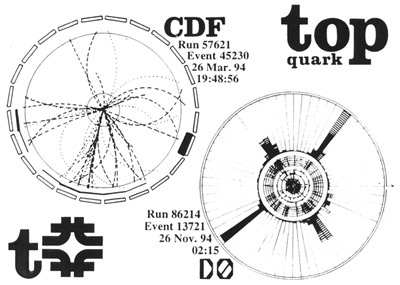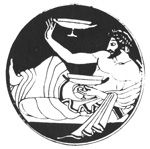"Golden Books" - A Little Bit of the Gods
 |
A Little Bit of the Gods
|
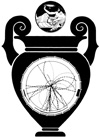 |
 |
![]()
Fermi National Accelerator Laboratory
Batavia, Illinois
Operated by Universities Research Association, Inc.
Under Contract with the United States Department of Energy
T IS POPULAR TO SAY that top quarks were produced in great numbers in the fiery cauldron of the Big Bang, disintegrated in the merest fraction of a second, and vanished from the scene until my colleagues learned to create them in the Tevatron, a giant particle accelerator near Chicago. That would be reason enough to care about top: to learn how it helped sow the seeds for the primordial universe that evolved into our world of diversity and change. But it is not the whole story; it invests the top quark with a remoteness that veils its real importance -- and it denies the immediacy of particle physics. HE REAL WONDER is that here and now, every minute of every day, the top quark affects the world around us. Through the uncertainty principle of quantum mechanics, top quarks and antiquarks wink in and out of an ephemeral presence in our world. Though they appear virtually, fleetingly, on borrowed time, top quarks have real effects.
FEW NUMBERS regulate the dimensions and character of the everyday world, from the size of atoms to the energy output of the sun. Only a generation ago, these parameters of the quotidian -- the mass of the proton, the mass of the electron, and the strengths of a few fundamental forces -- seemed givens, beyond the compass of science. Today, we have begun to discern links among them, to see how each of them might be understood and, eventually, computed. |
HE PROTON, the basic unit of the atomic nucleus of all the elements, is itself composed of up quarks and down quarks. We have discovered that the proton's mass is due mostly to the energy stored up in the "strong" force that holds the quarks together. By studying the force between quarks, we learn why the proton is the way it is.
E NOW BELIEVE that all the WE forces have equal strengths at very high energies. We perceive distinct strong, weak, and electromagnetic interactions because the symmetry -- the perfection -- that is evident at high temperatures is hidden in our low-energy world. Everything that happens from very high temperatures down to low temperatures is encoded in the way the forces evolve from the state of perfection to the state of nature. INCE TOP STANDS APART as very much heavier than the others, it has a is special influence on the evolution of the strong force, and so on the mass of the proton. If top weighed a bit more or less, the force that confines quarks inside a proton would be slightly stronger or weaker. The resulting change in the proton's mass would give our world a different character. The top quark's mass is expressed in the form of every flower and grain of sand, in every human face. TOP MATTERS! |
THIS BROADSIDE WAS PRODUCFD ON THE OCCASION OF CHRIS QUICG'S TALK, TOP QUARK SECRETS:
POSTCARDS FROM THE PARTICLE FRONTIER, IN THE HEINZ R. PAGELS MEMORIAL LECTURES
ORGANIZED BY THE ASPEN CENTER FOR PHYSICS, AUGUST 2, 1995.
Introduction
Chris Quigg is a member of the Fermilab Theoretical Physics Department. Educated in the hallowed halls of Yale University and the University of California at Berkeley, he continued his research at the State University of New York at Stony Brook before coming to Fermilab in 1974. Quigg served as Head of our Theoretical Physics Department from 1977 until 1987 when he took a leave of absence to serve as Deputy Director of the Superconducting Super Collider Central Design Group in Berkeley until 1989.
Quigg has advised students, physicists, laboratory directors, and advisory panels concerning the phenomenology and theory of high-energy physics experiments at accelerators around the world. His dedicated research and teaching at the University of Chicago, Ecole Normale Superieure in Paris, the University of Vienna, and Cornell University have brought him international renown for his studies of heavy quarks and his insights into particle interactions at ultrahigh energies.
Professor Quigg is a Fellow of the American Association for the Advancement of Science and of the American Physical Society. He is the author of many scientific papers and of a textbook on particle physics, and he is writing a new book for the general public, Grace in All Simplicity. He is the Editor of the Annual Review of Nuclear and Particle Science.
"A Little Bit of the Gods" is adapted from a talk given by Professor Quigg at Fermilab in March 1994. The International Symposium and Tribute in Honor of Robert R. Wilson on his 80th Birthday, "Celebrating an Era of Courage and Creativity," offered him the opportunity to eloquently recall for all in attendance a taste of the physics since Robert R. Wilson became the Founding Director of Fermilab. We are pleased to share it now for our readers' enjoyment of a story in modern physics and culture, as only Chris Quigg could tell.
A Little Bit of the Gods
 We are gathered today to welcome a new octogenarian, Robert Rathbun Wilson, to the ranks of the Truly Venerable. It is an occasion for respect and generosity, but I still must speak plainly. This Bob Wilson, this hoary sage who sits before us, came into the world at a time when cosmic rays hadn't even been invented yet. That, my friends, makes him old!
We are gathered today to welcome a new octogenarian, Robert Rathbun Wilson, to the ranks of the Truly Venerable. It is an occasion for respect and generosity, but I still must speak plainly. This Bob Wilson, this hoary sage who sits before us, came into the world at a time when cosmic rays hadn't even been invented yet. That, my friends, makes him old!
In the year of Bob Wilson's birth, a Parisian artist named Marcel Duchamp began a new movement in art, insisting on the artistic value of found objects -- or, as he later called them, readymades. Duchamp raised manufactured objects, the artifacts of an industrial society, to the dignity of Objects of Art simply through his own decision as an artist. One of his early masterpieces is a dog comb, on which the artist inscribed an enigmatic phrase: "Three or four drops of height have nothing to do with savagery."
Another path-breaking work is the snow shovel that bears its title as a work of art: In Advance of the Broken Arm.
Not only did Duchamp transfigure the world of art with his nudes descending staircases, but his readymades gave birth to theoretical physics as we know it today. The powerful symbolism of the shovel is manifest, of course... But look at his achievement, how much deeper it was: he took the work of others, added a few incomprehensible remarks, and presented it as his own insight. Every theorist who annotates a graph of experimental data and announces a discovery is an apostle of Duchamp!
In the end, I think it was Duchamp's follower, the Belgian surrealist Rene Magritte, who perfected and defined in his art the very essence of what it means to be a modern particle theorist. Who can read the haunting inscription of The Treachery of Images without thinking of theoretical physicists? The profundity -- the originality -- of the phrase, "This is not a pipe," is self-evident.
When asked about the meaning of his work, Magritte would reply, "My art speaks for itself," or, better, "I never said that." Truly, he is an inspiration to every theorist.
You have only to look around Fermilab to understand Bob Wilson's affinity for readymades. There is the sculpture, Broken Symmetry, a recycled warship. There is the bubble-chamber utility building, made from aluminum cans. And there is the (dare I say semipermeable?) meson lab roof, an assemblage of corrugated pipes. I can't help but wonder what enigmatic phrases might be written inside those sewer pipes.
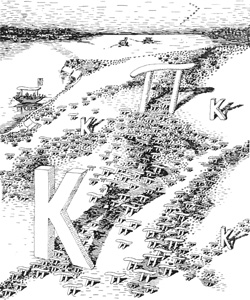 At the time of Bob Wilson's birth, it was not only the art world that was preoccupied with found objects. Our ancestors, the early subatomic physicists, relied on found beams, the radioactive emanations of radium and thorium. When thorium breaks apart, it expels a helium nucleus, leaving behind an atom of radium. The helium nucleus moves at nearly ten thousand miles a second. It leaves in its wake a contrail of ionization that you can see if you look closely under the right conditions.
At the time of Bob Wilson's birth, it was not only the art world that was preoccupied with found objects. Our ancestors, the early subatomic physicists, relied on found beams, the radioactive emanations of radium and thorium. When thorium breaks apart, it expels a helium nucleus, leaving behind an atom of radium. The helium nucleus moves at nearly ten thousand miles a second. It leaves in its wake a contrail of ionization that you can see if you look closely under the right conditions.
Radioactive sources are very convenient. You can carry one in a lead box, or in your pocket. It's always on -- there is never any question of the beam being up or down -- but there are some disadvantages. The helium nuclei travel only a few centimeters before they have spent all their energy ionizing air molecules. Their energy is limited by the energy stored in the radioactive nucleus. The fastest ones come out with only about one-sixteenth of the speed of light. That energy is about a million times smaller than we need to do experiments today.
Another limitation of found beams is that only a few kinds of projectiles are available. If you want to experiment with protons, you're out of luck.
Just as photographers can make wonderful images with natural light, or available light, the early subatomic scientists made revolutionary discoveries with their found beams. But modern photographers make an infinite variety of wonderful images using artificial light -- light made to their specifications. We need to make our own beams to see the world in new ways. To do the experiments our science demands, we need beams with specific qualities available on demand.
The quest to make those beams, by building the devices we call particle accelerators, was the adventure that drew Bob Wilson to Ernest O. Lawrence's lab, and into our field. For many of us, a little book by Wilson and Littauer1 was our introduction to the romance of the big machines. The possibilities those machines open for learning about nature bring us together at Fermilab: riggers and physicists, engineers and secretaries, graduate students and programmers -- and yes, even those hard-boiled characters from the Department of Energy.
The first time I gave a talk in this Norman Ramsey Auditorium, nearly twenty years ago, I noticed by chance that, when I wandered to the front of the stage, an echo of my voice came booming back at me. Behind some invisible line, the room seems normal; in front, it is like a whispering gallery. I spent the rest of that talk bobbing and weaving, trying to map out the boundary in detail. I must have seemed more than ordinarily distracted. It was really delightful to find one of the things that Bob Wilson had built for us to discover. I have it on good authority that he even intended some of them!
In those early years, the sense that we were in a new place, with discoveries large and small to be made every day, was inescapable. That optimism -- that feeling that anything is possible, that something good will happen -- is what animates science. To this day, every time I walk into the great vault of Wilson Hall, I feel a sense of lightness and possibility.
In those days, everyone was curious about the new terrain, even the 1970s equivalent of string theorists. Artifacts of the first survey experiments were everywhere. Bubble chamber pictures, first from the 30-inch chamber, hung in every office. They gave form to our developing ideas about multiple production -- the wholesale conversion of energy into matter. Richard Feynman knew Tom Ferbel's name from these pictures -- and Joe Lach's, and Ernie Malamud's. We were all in this together, exploring a new world.
When that world was new, we tried to follow everything about every experiment. Of course, the experiments were much simpler then, so there was much less to know, but there was also a great deal of solidarity and pioneer spirit.
There was also passion and drama. There was a lot of theater -- and some quite good science -- in those memorable Wine and Cheese Seminars by Experiment 26. The two principals, Lou Hand and Wendell Chen, would divide the hour and give conflicting interpretations of their data. Their joint seminars seemed like collaboration meetings held before a jury. You'll have some idea of the intensity of the discussions if I tell you that Drasko Jovanovic was moved to act as a peacemaker.
There is plenty of curiosity today -- our whole community has been on pins and needles waiting for top to show itself -- but experimental groups have learned to keep the passion and drama to themselves. This is a mistake. Think what would it be like if the CDF and DO Collaborations held public clashes between their top-now forces and no-top-yet forces. They could fill Chicago Stadium -- we could get the hockey crowd into particle physics! I can promise that the whole Fermilab theory group would be there.
In the days before the first settlers came to Weston, particle physics was a subject highly fragmented. Inhabitants of separated oases of understanding spoke in different untranslatable languages. Particle physicists doing one kind of experiment, or thinking about one kind of physics, found it hard to understand what other particle physicists were doing.
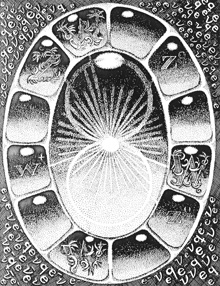 Now, by virtue of the experiments done over the last twenty-five years and the accompanying convergence of theoretical ideas, particle physicists have evolved a common language. A network of understanding links each new measurement, each new observation, to everything else we know. That gives us the possibility of recognizing harmony between different measurements. What is more important, it gives us the possibility of recognizing discord: noticing when an observation doesn't fit, so that either it must be discarded, or our understanding must be revised.
Now, by virtue of the experiments done over the last twenty-five years and the accompanying convergence of theoretical ideas, particle physicists have evolved a common language. A network of understanding links each new measurement, each new observation, to everything else we know. That gives us the possibility of recognizing harmony between different measurements. What is more important, it gives us the possibility of recognizing discord: noticing when an observation doesn't fit, so that either it must be discarded, or our understanding must be revised.
The idea that we can bring common understanding to apparently unrelated phenomena is basic to science. It is what we mean by progress. Think of the realization that heat is atoms in motion, which opens the way to understanding thermal phenomena through the laws of mechanics. Or think of the unification of the chemical properties of substances -- once the stuff of folklore -- with the behavior of atomic particles. In particle physics, too, an ever-denser network that links all our observations together is a testament to the growth of our understanding.
The best measure of how physics has changed since the early days of Fermilab is that everything we do now in experiments either was unknown when the laboratory was founded, or has been given an entirely new context by the developments of the last twenty-five years. Let's think about a few things that are happening right now:
The top search -- who knew about heavy quarks in 1967? More than a few people didn't believe in quarks at all.
-
The mass of the W-boson is being measured to ever-greater precision. The W-boson was a gleam in theorists' eyes back in those days.
-
The idea that in high-energy collisions, there are not just a few particles produced as we saw in the bubble chamber picture, but well-collimated sprays of particles called jets, and that two, or three, or four, or five of those jets may appear in high-energy collisions was inchoate, unexpressed.
-
There's a very rich program here at Fermilab and around the world studying b-quarks. In fact, Bob Wilson's other home, the Cornell laboratory, is the world center for the study of b-physics. Those particles, too, didn't exist, and in fact we had little reason to suspect them in 1967.
-
Charmed particles, the lightest of the heavy quarks, also were unknown experimentally, although they were speculated about. The study of charm has been an important part of Fermilab's fixed-target program.
All those research topics simply didn't exist before the discoveries of the last twenty-five years.
Other current problems have been with us for a long time, but their significance and interpretation are altered by what we have learned.
One of the Great Problems in particle physics is why we are here. How did there come to be an excess of matter over antimatter in the universe? We know that one element in that explanation has to do with the violation of a symmetry called CP, discovered in 1964 in decays of strange particles, the neutral K mesons. We still haven't completely incorporated that phenomenon into our understanding, and yet, we now believe that the rate at which CP violation occurs and the character of that phenomenon are tied closely to the masses of the heavy quarks. When our experimental colleagues explore the character of CP violation, they, too, are making a measurement of the mass of the top quark. That linkage between different sorts of experiments is extraordinary and new.
-
Other experiments that we hope to do in the future, seeking oscillations among different species of neutrinos, were in the air twenty-five years ago, but they are given new force by what we've learned. And no one had even dreamed of the third neutrino, the tau neutrino.
-
The search for new phenomena in the strong interactions, being explored in all three of our collider experiments, is given context by the theory of the strong interactions, quantum chromodynamics.
I've not mentioned the Fermilab experiments that contributed specifically to these developments, nor the experiments at the other great labs -- CERN and SLAC and elsewhere. The progress in accelerator technology, experimental technique, and scientific achievement over the past twenty-five years has been heroic.
This extraordinary renewal of our subject means that we have been living in a series of golden ages. And there are golden days to come. Today, we hang on every word about top, and it would take only a small miracle of technique to make a new world of b-physics. We are pushing back many frontiers, making opportunities for profound discoveries now. Machines that will enable us to complete the gauge-theory revolution are on the horizon.
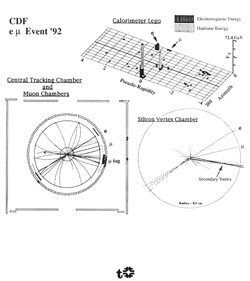 Just over a year ago, in this auditorium, the CDF Collaboration showed an event -- a computer reconstruction -- that could represent the production and decay of a top quark and a top antiquark. The unmistakable signature of top-antitop production, as all of us had been saying for years, would be a top decaying into bottom + electron + unobserved neutrino, together with an antitop decaying into antibottom + muon + unobserved neutrino. We look for one electronic decay and one muonic decay because that combination occurs rarely in ordinary topless events. The top and antitop both decay essentially at the instant they are produced. Each bottom quark travels a few millimeters or so before decaying into a charmed quark and other particles. The chain of events that would signal top is easy to sketch on a blackboard, but requires extraordinary efforts to record and decode.
Just over a year ago, in this auditorium, the CDF Collaboration showed an event -- a computer reconstruction -- that could represent the production and decay of a top quark and a top antiquark. The unmistakable signature of top-antitop production, as all of us had been saying for years, would be a top decaying into bottom + electron + unobserved neutrino, together with an antitop decaying into antibottom + muon + unobserved neutrino. We look for one electronic decay and one muonic decay because that combination occurs rarely in ordinary topless events. The top and antitop both decay essentially at the instant they are produced. Each bottom quark travels a few millimeters or so before decaying into a charmed quark and other particles. The chain of events that would signal top is easy to sketch on a blackboard, but requires extraordinary efforts to record and decode.
In addition to the usual blizzard of particles, the CDF event has a muon and an electron, both far from other tracks, so relatively easy to identify, plus a few tracks that originate not from the point where proton and antiproton collided, but from a point 3 millimeters away -- just as a bottom-decay would. The silicon vertex detector can resolve a secondary decay about a tenth of a millimeter from the collision point.
The machine that gave us this picture is about three stories high, weighs 5000 tons, contains 100,000 channels of electronics, and has, buried deep within it, that fantastically precise silicon vertex detector.
What an enormous step this is from the primitive detectors of Bob Wilson's youth! The only thing that hasn't changed is how experimenters spend their time. In the good old days, experimenters sat in darkened rooms, staring straight ahead, waiting for charged particles to make bright spots on phosphor-coated screens. Today, experimenters sit for hours watching charged particles make bright spots on the phosphor-coated screens of their computer displays.
This picture was extremely significant to me. I remember having a powerful emotional reaction. It really didn't matter at the time whether this particular event was a top and antitop, it was just so amazing that people had made a device that could see, in real space and under the battle conditions of an experiment, all the elements of the top-antitop signature. Learning how the detector really behaves and what nasty surprises Nature has up her sleeve is what separates the experimental sheep from the goats -- and I guess they are still separating -- but this picture showed me that the possibility of discovering top had become real. I was moved by the improbability of that feat. It's really a wonderful achievement, even if we don't yet know the answer.
Why does this matter? What is important about the search for top? For particle physics, finally observing the top quark will be satisfying, because we know it must be there. But discovering top is only the beginning. Measuring the mass of the top quark and, at the same time, measuring to high precision the mass of the W-boson, the carrier of the weak force, will test our network of understanding about the weak and electromagnetic interactions.
We believe we know how to compute the strength of the weak interaction -- the radioactivity that makes energy in the sun. In fact, the calculation is almost done, but one piece is missing. All we need to do to predict the mass of the W-boson and therefore the strength of radioactivity -- the rate at which radioactive decays occur -- is to measure the mass of the top quark.
What a great feeling of power! And what frustration not to know the number -- but we know that we're soon going to be able to finish that calculation and compare it with the real answer. That's very exciting.
Furthermore, since top is the heaviest quark we've ever seen (or soon will see), it gives us a window on new physics. Many of the puzzles that confront us -- what distinguishes the weak interactions from the electromagnetic, for instance -- seem to be connected with particles and forces that are very sensitive to heavy quarks. The top quark, the heaviest of them all, will become a new probe -- a new experimental tool -- as soon as it is found.
That's a little bit of why the top quark matters for particle physics. But why does it really matter? Why does it matter for the world around us and for our perception of that world?
It is popular to say that top quarks were created in great numbers in the early moments after the big bang some ten billion years ago, disintegrated in a fraction of a second, and vanished from the scene until my colleagues learned to create them in the Tevatron at Fermilab. That would be reason enough to be interested in top: to learn how it helped sow the seeds for the primordial universe that has evolved into the world of diversity and change we live in.
But it is not the whole story; it invests the top quark with a remoteness that hides its real importance -- and overlooks the immediacy of particle physics. The real wonder is that here and now, every minute of every day, the top quark affects the world around us. It's very important for us as particle physicists to know, and to remember, and to recite every day, "This matters."
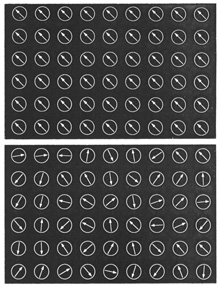 The top quark aside, what have we learned over the last twentyfive years? We've learned that matter is made of a small number of constituents that appear to be structureless, indivisible particles - the real atoms. Also, we've learned that the traditional forces of nature, the ones that have been talked about for fifty years -- gravity, electromagnetism, the weak interaction, and the strong interaction -- all seem to be governed by symmetries. Their character is determined by patterns that we observe in nature.
The top quark aside, what have we learned over the last twentyfive years? We've learned that matter is made of a small number of constituents that appear to be structureless, indivisible particles - the real atoms. Also, we've learned that the traditional forces of nature, the ones that have been talked about for fifty years -- gravity, electromagnetism, the weak interaction, and the strong interaction -- all seem to be governed by symmetries. Their character is determined by patterns that we observe in nature.
And we have a hint, from the hidden symmetry between the weak and electromagnetic interactions, that there may be another force. The origin of that force is not understood. That's one of the great puzzles we face. The special role of hidden symmetries is illuminated by an allegory of three worlds.
The Crystal World. Think what it would be like to be a very tiny physicist, a millionth of a millionth of normal size, living and working in the recesses of a magnetic crystal of iron. The laws of electromagnetism that, together with quantum mechanics, determine the shape of the crystal world, display an exact rotational symmetry. But this picophysicist would have a hard time learning that nature favors no direction over any other, because on every street corner of the picoworld there stands a compass, and the needle of every compass points the same way. The compasses are monuments to the way things were at a time that no one remembers, just after this world came out of the fiery furnace.
All these compass needles make a magnetic field that pervades the whole world, surrounding the picophysicist and his instruments. If the picophysicist's picoinstruments were not much affected by the magnetic field of the regimented compass needles, our tiny colleague might find that the laws of nature look approximately the same from every direction. But if the picoapparatus were strongly influenced by magnetism, the picoinvestigator might miss the idea of rotational symmetry altogether. In any event, picoexperiments would never reveal that rotation symmetry is exact.
Nor could the picophysicist show directly that the orientation of the compasses, the emblem of stability and order in this world, is determined by happenstance. (You can imagine the cultural significance that would have accumulated over the years for these compass needles all pointing in the same direction.) Too small by far to reorient all the compass needles at the same time, the picophysicist would find it an impossible task to show that any other alignment is equivalent. The picoscholar could at best conjecture that there is a symmetry hidden behind the order of his world and test the idea through its consequences.
At some considerable peril to our diminutive colleague, we macroscopic outsiders could be of assistance. We could raise the crystal's temperature to 1040 kelvins, until heat's random motion disordered the needles. Then, as the crystal cooled, we could watch all the street-corner compasses settle into a new pattern, equally regimented but differently aligned. The preferred direction would be changed on every cycle of heating and cooling, with no memory of what had gone before. It would reveal by its aleatory nature the hidden rotational symmetry that governs the magnetic crystal picoworld.
A Perfect World. There is another world, of sublime perfection, where time and space flow like the still waters of a deep river. No street corners are marked by prehistoric monuments, no direction markers point the one true way. Vast expanses of space and time are unrelieved flatness.
In this egalitarian world, matter particles and force carriers all dash about at the speed of light, exchanging information in brief encounters, never stopping to form lasting associations. Liaisons are here today, gone today. There are no atoms, no structures, and no condensed-matter physicists. (I think of it as Leon Lederman's Paradise.) All particles are brothers and all forces are one. It is a world of perfect symmetry and complete disorder -- not to say anarchy, for symmetry rules with so heavy a hand that it imposes an unrelenting sameness, a stability in mutability. Everything is interchangeable. It is a perfectly boring world.
The Third World. In a world of diversity, space is not punctuated by a crystal framework, but runs, like time, with unbroken continuity. In the eyes of nature's laws, no time and place is preferred to any other; no direction is superior to the rest. Yet this is a world of distinctions, a world in which differences matter.
Quarks stand apart from leptons. Leptons are free, quarks confined. Every quark, every lepton has a distinct personality, every force a peculiar character. Some changes -- the actions of forces -- are everyday events. Others happen once in a proton's lifetime.
Some matter particles and force carriers have weight, can come to rest. Others, weightless, are in perpetual motion at the cosmic speed limit. Some particles that weigh are ephemeral; they transmute, decay.
Other particles can live forever. In this world of mass, composites form, stable structures are commonplace. Accumulations of matter ripple the fabric of space-time.
Like the magnetic crystal, this is a world of bias. A pervasive tilt, set at random when the world cooled from a state of symmetry, disorder, and perfection, veils an exact symmetry. It distinguishes up quarks from down, electrons from neutrinos; it invests particles with mass.
This world is ours. Like our picocolleague in the crystal world, we cannot hope to undo the bias or change it for another. We must peer through the veil to discover the source of bias, to learn what hides the symmetries that lie behind the order. Studying collisions of particles at extremely high energies is the most incisive way to peer through the veil, but indirect means may also be revealing.
If the perfect world is a hot version of our own world, then what happens at very high energies -- what happens in that state of perfection at high temperatures -- is encoded in the fine structure constant, the number that determines the strength of electromagnetism. Because if it is so that at very high energies all forces are equal and have the same strength, and' the residual differences we see in our cold, cruel, low-energy world are due to the hiding of the symmetry -- the perfection -- that is evident at high temperatures, then everything that happens between here and there, everything that happens from very high temperatures down to low temperatures influences the value of this number that determines the size of atoms and the strength of electromagnetism. Top, bottom and even the supersymmetric partners that we might some day discover determine the dimensions and character of this world that we live in. Unified theories such as the one I've speculated about just now are not empty, untestable exercises in metaphysics, despite the current of science writing that equates theoretical theory (and theories of everything) with the occult.
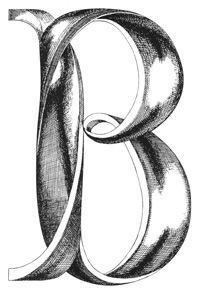 Quite the contrary, over the last twenty-five years, particle physics has progressed dramatically, moving important questions from the realm of metaphysics to the realm of quantitative science. A few numbers determine the dimensions and character of the everyday world, from the size of atoms to the energy output of the sun. Only a generation ago, these parameters of the quotidian -- the mass of the proton, the mass of the electron, and the strengths of the fundamental interactions -- seemed givens, beyond the reach of science. In 1967, if you had come to a physicist and said, "I want to know what makes the mass of the proton different from the mass of the electron," you would have been ushered out of the room. Those were just numbers. They were fixed. They were the way they were.
Quite the contrary, over the last twenty-five years, particle physics has progressed dramatically, moving important questions from the realm of metaphysics to the realm of quantitative science. A few numbers determine the dimensions and character of the everyday world, from the size of atoms to the energy output of the sun. Only a generation ago, these parameters of the quotidian -- the mass of the proton, the mass of the electron, and the strengths of the fundamental interactions -- seemed givens, beyond the reach of science. In 1967, if you had come to a physicist and said, "I want to know what makes the mass of the proton different from the mass of the electron," you would have been ushered out of the room. Those were just numbers. They were fixed. They were the way they were.
That didn't stop professors from using these questions to torture students and stretch their minds, of course. I used to hate those homework problems that asked, "What would happen to the world if the fine structure constant differed by ten percent?" Or, "What would happen to the world if the proton and electron had the same mass?" Who cared? These numbers couldn't possibly be changed; why bother with this?
Well! What we have learned over the past quarter of a century is that those numbers might have been different. They are numbers we can hope to understand. Having lost just a little of the certainty of youth, I now find these questions unavoidable -- and important.
The search for the top quark has caused me to think anew about top's influence on the mundane. In a unified theory of the fundamental interactions, the strengths of the strong, weak, and electromagnetic interactions all are equal at some very high energy called the unification scale. The different strengths we observe in our low-energy world arise because the interactions evolve differently with energy. How they depend on energy depends on the character of the forces themselves and on the spectrum of particles that appear from very high energies down to the energy scale of common experience. Because the top quark stands apart as very much heavier than the other quarks, it has a special influence on the strengths we measure.The mass of the top quark is encoded in the strengths of the forces that rule the everyday world.
 But that is only the beginning. The proton is made of up and down quarks bound together by gluons, the carriers of the strong force. We know through the theory of quantum chromodynamics the basics of how those quarks and gluons interact and how they come together to make a proton. In a sense we can already make reasonably precise, the proton's mass is governed by the strength of the strong force between quarks, which is influenced by the top quark. The top quark is not a constituent of the proton, but if top weighed ten times more or less, the proton mass would shift up or down by about twenty percent. This world -- our world -- would have a very different character.
But that is only the beginning. The proton is made of up and down quarks bound together by gluons, the carriers of the strong force. We know through the theory of quantum chromodynamics the basics of how those quarks and gluons interact and how they come together to make a proton. In a sense we can already make reasonably precise, the proton's mass is governed by the strength of the strong force between quarks, which is influenced by the top quark. The top quark is not a constituent of the proton, but if top weighed ten times more or less, the proton mass would shift up or down by about twenty percent. This world -- our world -- would have a very different character.
That's an extraordinary progression, transforming a question that was outside the realm of science to an approachable scientific problem. We have also begun to close in on the origin of the electron's mass. Understanding what sets the scale of everything around us -- the properties of matter -- now seems within our reach.
Particle physics is concerned with this world: from the conditions in the early universe from which the world evolved to the here and now of ordinary matter: why it exists, why it takes the form it does.
Our research is remote from everyday experience, but it is the everyday world we seek to understand.
I'd like to close by recalling a conversation with our shy and retiring colleague, Peter Limon. Toward the end of a very cerebral, yet seductively earthy, bottle of Zinfandel, I asked Peter to tell me what he likes best about the Tevatron.
Peter chewed his Zinfandel meaningfully. Then he said, "The neatest thing is that you can actually store up all those antiprotons day after day after day and put them in the machine when you want to . . .
"You say, 'I'm going to put p-bars in the machine at midnight tonight,' and you do that, and you accelerate them, and you squeeze the beams into little tiny spots at B0, and you bring them into collision. I'm not only fascinated -- every time it happens, I'm surprised."
Peter poured himself the last of the wine. "I think it's really spectacular," he said, "particularly since I know these people who are doing it." He rolled his eyes, then became very serious.
"You know, if Fermi and Feynman and the gods were doing it, you wouldn't think anything about it, right? But normal, everyday human beings are doing this. What's amazing is that regular people get together and make these amazing things work."
To Bob Wilson on his eightieth birthday, to all the builders and makers of this inspiring place -- this place of boundless horizons -- thank you for giving us normal, everyday human beings the chance to discover, within every one of us, a little bit of the gods.
1 Robert R. Wilson and Raphael Littauer, Accelerators: machines of nuclear physics (Anchor Books, Garden City, N. Y., 1960). [back]
Participating Institutions
Acad. Sin. Taiwan●los Andes●ANL●Arizona●BNL●Bologna●Brandeis●Brown
UC/Davis●UC/Irvine●UCLA●UC/Riverside●CBPF●Chicago●CINVESTAV
Columbia●Delhi●Duke●Fermilab●Florida State●Frascati●Harvard●Hawaii
Hiroshima●IHEP/Protvino●Illinois●Illnois/Chicago●Indiana●Iowa State
IPP (McGill/Toronto)●Johns Hopkins●KEK●Korea● Kyungsung●LBL●Maryland
MIT●Michigan●Michigan State●Moscow State●Nebraska●New Mexico●New York
Northeastern- Northern Illinois● Northwestern●Notre Dame●Osaka City●Padova
Panjab●Pennsylvania●Pisa●Pittsburgh●Purdue●Rice●Rochester●Rockefeller
Rutgers●Saclay●Seoul●SSCL●SUNY/Stony Brook●Tata●Texas A&M
Texas/Arlington●Texas Tech●Tsukuba●Tufts●Wisconsin●Yale
Thanks
Sue Grommes ● Adrienne Kolb ● Rocky Kolb ● Bruce Chrisman
John Peoples ● Robert R. Wilson ● Leon M. Lederman ● Jane S. Wilson
S. Chandrasekhar ● Leonard Euler's Illustrator ● Angela Gonzales
Pablo Picasso ● East Indian Mythology ● 5th Century B.C. Athenian Vase
Painters and Potters ● Hans Bethe ● Fermilab Photography ● Al Johnson
John Keats ● Emily Dickinson ● Jean Lemke ● Marcel Proust ●
Chocolate
Lillian Hoddeson ● William Shakespeare
● Norman F. Ramsey
Chris Quigg ● 19th Century Illustration Depicting a Mechanical Universe
5th Century B.C. Greek Mythology ● Leonardo da Vinci
![]()
This publication was selected from the treasures of the Fermilab Archives.







